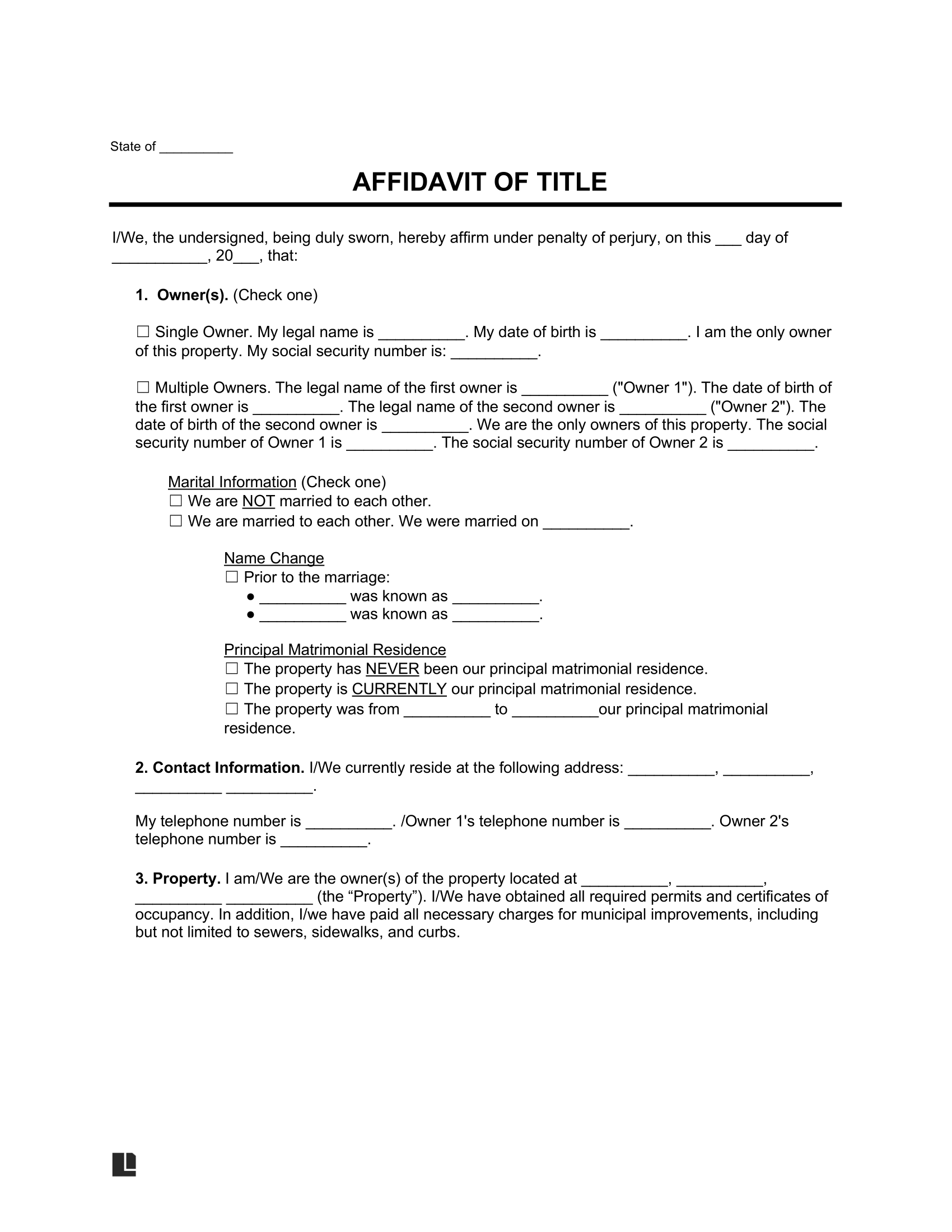An affidavit of title is a notarized sworn statement created by a property seller that serves as proof of property ownership and the legal right to sell the property. This document provides essential protection for buyers during real estate transactions involving homes, condominiums, or land.
It confirms the seller’s ownership and asserts their right to transfer the property, ensuring transparency and security in the sale process.
When to Use
How to Write
Follow the steps below to write an affidavit of title.
Step 1 – Owner and Marital Details
Provide the full name, date of birth, and social security number of the current property owner(s). Indicate if there are one or multiple owners, including the same information for each if applicable.
If there are multiple owners, specify if they are married, including the marriage date, any prior names (like maiden names), and whether the property is or was their principal matrimonial residence.
Step 2 – Enter Contact Details
Provide the owner’s address, including the street address, city, state, and zip code. Also, specify each owner’s telephone number.
Step 3 – Property Description
Provide the full address (street, city, state, zip code) of the property subject to this affidavit.
Specify whether the property has had any additions or substantial improvements made. If yes, provide a description of the additions and/or improvements and the date those were performed.
Step 4 – Note Liens, Encumbrances, and Bankruptcy
List any liens or encumbrances on the property, specifying the type (e.g., judgment, tax lien) and details.
Mention any adverse tax claims and indicate if the owner(s) has declared bankruptcy, including the date and any outstanding claims.
Step 5 – Occupancy Information
Specify whether current tenants live on the property or if there are any outstanding property leases. If yes, provide the date the lease will expire.
Step 6 – Sign and Notarize
All owners must sign the affidavit of title in front of a notary public, who will verify identities and witness the signatures. Notarization is required for legal validity.
Keep a copy for future transactions and review the affidavit for accuracy before signing.
Combining with a Quitclaim Deed
Combining a quitclaim deed with an affidavit of title enhances the protection for the buyer despite the inherent lack of warranties in a quitclaim deed. The affidavit requires the seller to disclose any known claims or issues related to the property, which can clarify the ownership situation.
While this combination doesn’t offer the same guarantees as a warranty deed, it promotes greater transparency in the transaction, allowing the buyer to make a more informed decision.
Affidavit of Title Sample
Below, you can find what an affidavit of title typically looks like.

Common Problems and How to Fix Them
In real estate, there are certain situations that will raise flags for buyers. Here are common problems and how to solve them:
Liens on the Property: Make sure all liens (tax liens, mechanic’s liens) are disclosed in the affidavit. Ask the seller for documentation that any liens have been paid off or will be paid off before the transaction.
Joint Ownership Issues: If the property is owned jointly (by a married couple or business partners), make sure all owners are aware of and agree to the sale. This should be included in the affidavit so there are no future ownership disputes.
Pending Legal Claims or Disputes: Ask the seller to disclose any active lawsuits, disputes, or judgments against the property. Make sure these are disclosed so you don’t inherit any unexpected legal headaches.
Seller’s Bankruptcy: If the seller has filed for bankruptcy, make sure they have the right to sell the property free of creditor claims. This should be included in the affidavit along with dates and case numbers.
Occupancy or Lease Agreements: If the property is occupied by tenants, make sure the affidavit includes details about lease agreements and expiration dates. So you don’t get any surprises about tenant rights after you buy.
Frequently Asked Questions
I Have Bankruptcy on My Record. What Happens if I Leave It Off My Affidavit of Title?
Don’t leave anything off your affidavit, especially your bankruptcy history. Omitting facts on this sworn document can be considered fraud and could void the sale and cause legal problems.
I Want to Buy a Property, but the Owner Refuses to Sign an Affidavit of Title. Should I Be Concerned?
You should be concerned if a person refuses to sign an affidavit of title. A list of potential concerns is below:
- The person doesn’t own the property.
- The person owns the property with another person who doesn’t want to sell or doesn’t know about the proposed sale.
- There are liens on the property.
- The person is not authorized to sell the property for some other reason.
How Do I Remove a Mechanic’s Lien From the Title if I’ve Already Paid?
If you’ve paid off a lien, ask the lienholder for a release with proof of payment. If they don’t cooperate you may need to file a “quiet title” lawsuit to get the lien off the property records.
